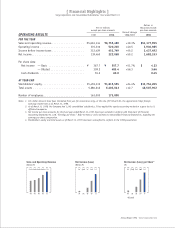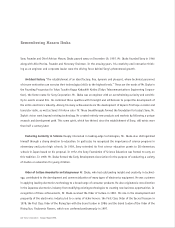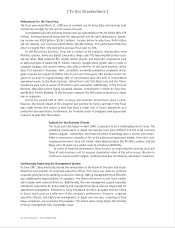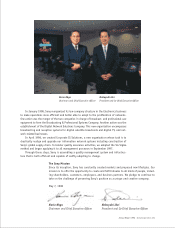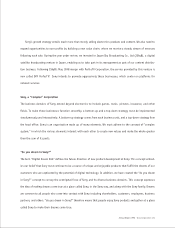Sony 1998 Annual Report Download - page 6
Download and view the complete annual report
Please find page 6 of the 1998 Sony annual report below. You can navigate through the pages in the report by either clicking on the pages listed below, or by using the keyword search tool below to find specific information within the annual report.[4] Sony Corporation Annual Report 1998
[ To Our Shareholders ]
Performance for the Fiscal Year
The fiscal year ended March 31, 1998 was an excellent one for Sony. Sales and earnings both
reached record highs for the second consecutive year.
Consolidated sales and operating revenue were up substantially to ¥6,755 billion ($51,178
million). Earnings improved along with the sales growth and the yen’s depreciation. Operat-
ing income was ¥520 billion ($3,941 million), income before income taxes ¥454 billion
($3,437 million), and net income ¥222 billion ($1,682 million). This performance lifted the
return on equity from 11% during the previous fiscal year to 14%.
In the Electronics business, Sony had a number of hit products. Among them were
MiniDisc systems, home-use digital camcorders, Wega color TVs featuring flat-surface cath-
ode ray tubes, VAIO notebook PCs, digital cellular phones, and electronic components such
as optical pickups. A weakening PC market, however, brought down growth rates in sales of
computer displays and caused memory chip sales to decline. In the Game business, which
Sony first entered in December 1994, cumulative worldwide production shipments of our
game consoles has topped 30 million units in just over three years. This business sector has
grown to account for approximately 10% of consolidated sales and 22% of consolidated
operating income. In the Music business, Celine Dion’s Let’s Talk About Love and the Titanic
soundtrack each sold in excess of 19 million units worldwide. Additionally, in the Pictures
business, there were several highly successful releases, including Men in Black, Air Force One,
and My Best Friend’s Wedding. In the Insurance segment, the life insurance business in Japan
saw an expansion.
During the second half of 1997, currency and economic turmoil took place in Asia.
However, the overall impact of this situation was positive for Sony’s earnings in the fiscal
year under review. One reason is that Asia plays a major role in Sony’s operations as a
production and export base. Furthermore, our financial center in Singapore took appropriate
measures to deal with the turmoil.
Outlook for the Business Climate
The fiscal year that began in April 1998 is expected to be a challenging one for Sony. The
operating environment in Japan has become even more difficult and the Asian economy
remains sluggish. Furthermore, the future direction of exchange rates is unclear and compe-
tition is expected to intensify in the world audiovisual equipment market. Given this chal-
lenging environment, Sony will market value-added products like MiniDisc systems, and the
Wega color TV series on a global scale to enhance profitability.
In terms of financial performance, Sony focuses on improving the earnings and cash
flows of each business unit to increase shareholder value of the entire group. We plan to
continue to improve profit margins, carefully select new investments, and reduce inventories.
Continuously Improving the Management System
In June 1997, Sony drastically altered the composition of the Board of Directors and estab-
lished the new position of corporate executive officer. This move was made to reinforce
corporate governance by speeding up decision-making, making management more efficient,
and clarifying the responsibilities of managers. The Board of Directors is now much smaller
and includes more external directors. Additionally, the new management system separates
individuals responsible for policy-making and oversight from those who are responsible for
operational management. Furthermore, Sony introduced incentive programs that are linked
to Sony’s stock price as a reflection of the company’s performance. Directors, corporate
executive officers, and high-level management in Japan and overseas, including at Sony
Group companies, are covered by the programs. This action more closely aligns the interests
of Sony’s management with shareholder value.



